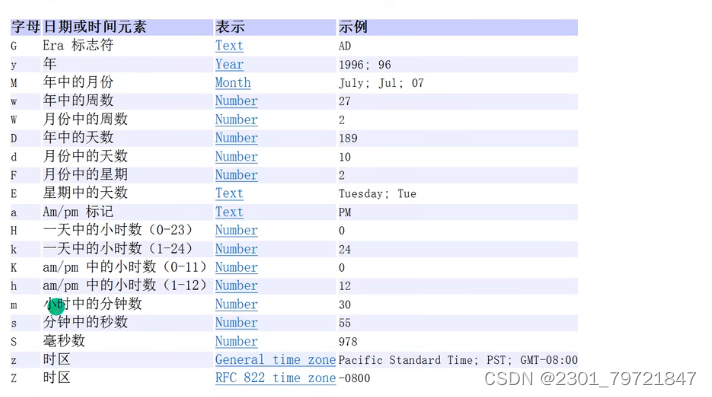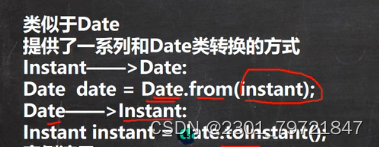目录
目录
一.Arrays类
二.System常见方法
三、Biglnteger和BigDecimal(高精度)
1.Biglnter的常用方法
2.BigDecimal常见方法
3.日期类
1)第一代日期类
2)第二代日期类
3)第三代日期类
一.Arrays类
Arrays包含了一系
列静态方法,用于管理或操作数组(比如排序和搜索)
Integer[] s={1,2,3};//1.Arrays.toString方法,遍历数组//2.Arrays.sortArrays.sort(s);//默认排序(从小到大排序)//定制排序(类似于c++的sort(a,a+n,cmp),自行定义排序规则Arrays.sort(s, new Comparator<Integer>() {@Overridepublic int compare(Integer o1, Integer o2) {Integer n1=(Integer)o1;Integer n2=(Integer)o2;return n2-n1;}});//System.out.println(Arrays.toString(s));//3.binarySearch通过二分搜索法进行查找,要求必须排好序//注:如果在数组中找不到该元素,则返回return-(low+1)//low表示的是该元素本该在数组中的位置//例如在{1,2,5,8}中找6,那它的位置本应该是5后面,8前面,即low为3.//4.copyOf(数组元素的复制)//若拷贝的长度大于s.length,新数组就相当于在原数组后面加null(对于Integer类的数组来说)Integer[] s1=Arrays.copyOf(s,s.length);//将s数组的s.length个元素复制到s1中//5.fill(数组的填充)Arrays.fill(s,100);//将s数组中的所有元素全部填充为100.//6.equals(比较两个数组元素内容是否一致)Arrays.equals(数组1,数组2)返回的是boolean类型//asLIst(将一组值转换为list)List asList=Arrays.asList(2,5,6,8);二.System常见方法
-
//1.exit 退出当前程序//System.exit(0);//括号中的数字表示一个状态,0表示正常的状态//2.arraycopy:复制数组元素,比较适合底层调用,一般使用Arrays.copyOf完成复制数组int[] s1={1,2,3};int[] s2=new int[3];//其含义为从s1数组索引为零的位置开始拷贝3个字符到s2数组(从s2数组的索引为0的位置开始)//拷贝的长度不能大于s2的长度,否则程序会报错System.arraycopy(s1,0,s2,0,3);System.out.println(Arrays.toString(s2));//3.currentTimeMillens (返回当前时间距离1970-1-1的毫秒数)System.out.println(System.currentTimeMillis());//4.gc(运行垃圾回收机制)System.gc();
三、Biglnteger和BigDecimal(高精度)
1.Biglnter的常用方法
BigInteger bigInteger = new BigInteger("999999999999999999999");BigInteger bigInteger1 = new BigInteger("111111111111");//加BigInteger add=bigInteger.add(bigInteger1);//减BigInteger subtract=bigInteger.subtract(bigInteger1);//乘BigInteger multiply=bigInteger.multiply(bigInteger1);//除BigInteger divide=bigInteger.divide(bigInteger1);2.BigDecimal常见方法
BigDecimal bigDecimal = new BigDecimal("1.1111111111111111111");BigDecimal bigDecimal1 = new BigDecimal("0.111111111");//进行加、减、乘运算时同BigInteger相同//进行除法运算时,要注意结果可能会出现无限循环小数的结果。//因此在小数进行除法运算时,应设置精度//如果结果是无限循环小数,就会保留被除数的精度.BigDecimal s1=bigDecimal.divide(bigDecimal1,BigDecimal.ROUND_CEILING);3.日期类
1)第一代日期类

Date d=new Date();//获得当前系统时间//通过指定毫秒数得到时间System.out.println(d);//输出形式为Sun Mar 10 10:00:29 CST 2024Date d1=new Date(344567443);SimpleDateFormat sdf=new SimpleDateFormat("yyyy年MM月dd日 hh:mm:ss E");String fun=sdf.format(d);//将日期转换成指定格式的字符串.//将一个格式化的String转换成对应的 DateString s1="2024年01月01日 10:20:30 星期一";Date parse= sdf.parse(s1);//这里有一个转换异常,可以使用throws抛出。2)第二代日期类
//Calender是一个抽象类,构造器的属性为privateCalendar n=Calendar.getInstance();//通过getInstance获取实例// 以下是获取日历对象的某个日历字段int year=n.get(Calendar.YEAR);//年//由于Calendar在返回月份时,是按照0开始编号,所以需要在后面加上1int month=n.get(Calendar.MONTH+1);//月int day=n.get(Calendar.DAY_OF_MONTH);//日int hour=n.get(Calendar.HOUR_OF_DAY);//小时int min=n.get(Calendar.MINUTE);//分钟int second=n.get(Calendar.SECOND);//秒//Calendar不同于date,没有专门的格式化的方法,我们自己来设置3)第三代日期类
---LocalDate:只包含日期,可以获取日期字段
---LocalTime:只包含时间,可以获取时间字段
---LocalDateTime包含日期+时间,可以获取日期和时间字段.
//LocalTime和LocalDateTime使用方法同LocalDate相似.LocalDate n1= LocalDate.now();//获取当前时间System.out.println(n1.getYear());System.out.println(n1.getMonth());System.out.println(n1.getDayOfWeek());DateTimeFormatter格式日期类
LocalDateTime fun=LocalDateTime.now();System.out.println(fun);//输出结果为 2024-03-10T10:02:08.822//类似于第一代日期类的SimpleDateFormatter//DateTimeFormatter//先定义一个标准格式DateTimeFormatter n=DateTimeFormatter.ofPattern("yyyy年MM月dd日 HH小时mm分钟ss秒");String s=n.format(fun);Instant时间戳







:服务器管理(十四)之监控磁盘使用)






常用模块)



3)

